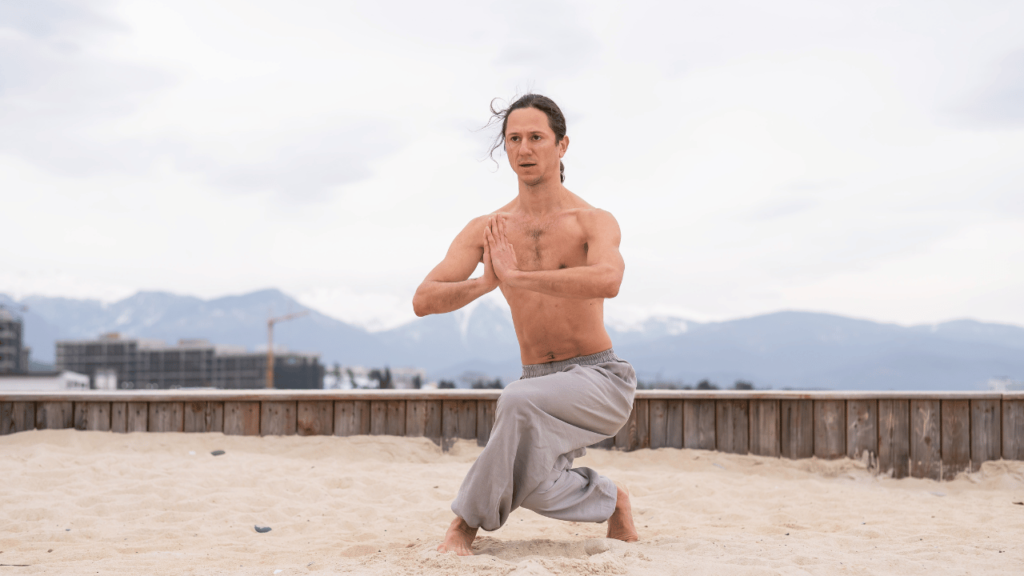Qigong Meditation Exercises Harmonizing Qi The Power of Qigong Meditation

Welcome to our guide on qigong meditation exercises! In this article, we will explore the ancient Chinese practice of qigong meditation and its powerful impact on mental, physical, and spiritual well-being. Qigong meditation combines controlled breathing, gentle movement, and meditation techniques to promote harmony and balance within the body.
Qigong meditation is rooted in the belief that by cultivating the energy and strength of nature, known as qi, we can unlock the body’s potential for healing and overall vitality. Throughout this article, we will delve into the different types of qigong exercises, techniques, and the numerous benefits they offer. Whether you are new to qigong or seeking to deepen your practice, this guide will provide valuable insights and information.
Key Takeaways:
- Qigong meditation combines controlled breathing, gentle movement, and meditation techniques to promote overall well-being.
- There are two main categories of qigong: active qigong (with intentional movement) and passive qigong (with stillness and breath control).
- Benefits of qigong meditation include improved balance, reduced stress levels, lower risk of chronic disease, and improved focus.
- Qigong can be practiced by people of all ages and fitness levels, but it is important to consult with a healthcare provider before starting any new exercise routine.
- Incorporating qigong meditation into your daily life can bring peace, balance, and holistic wellness.
What is Qigong Meditation? Understanding the Ancient Chinese Healing Practice
Qigong meditation is an ancient Chinese healing practice that combines controlled breathing, gentle movement, and meditation. It is a holistic approach to promoting mental, physical, and spiritual health.
The practice aims to cultivate the energy and strength of nature into the body, harnessing the power of qi, or life force energy, to promote well-being. In traditional Chinese medicine, it is believed that poor health is caused by blocked energy flow through the body’s twelve meridians, and qigong seeks to restore this flow.
Qigong meditation is deeply rooted in Chinese culture and has been used for centuries for exercise, recreation, relaxation, preventative medicine, and physical and mental healing. Although the theory of qi energy lacks scientific research, qigong remains a popular practice for promoting overall well-being.
Qigong meditation offers a unique combination of controlled breathing techniques, gentle movements, and focused awareness. By synchronizing the breath with movement, practitioners can release tension, reduce stress, and enhance their mind-body connection.
In the words of a qigong practitioner, “Qigong meditation helps me cultivate a state of serenity, allowing me to tap into the energy of the natural world and align my mind, body, and spirit. It’s a powerful practice for promoting well-being on all levels.”
Through qigong meditation, individuals can develop a deep sense of relaxation and inner calm. The practice encourages them to be fully present in the moment, letting go of stress, worries, and distractions.
With regular practice, qigong meditation has the potential to enhance mental clarity, improve physical health, and promote emotional balance. It is a gentle yet powerful practice that can be integrated into daily life for those seeking holistic wellness.
Types of Qigong Meditation Exercises Active and Passive Techniques
Qigong meditation, a powerful practice rooted in ancient Chinese healing traditions, encompasses various techniques that promote overall well-being. The practice can be broadly categorized into two main types: active qigong and passive qigong.
Active Qigong:
Active qigong, also known as dong gong, involves controlled movements and intentional breathwork to enhance yang energy. Yang energy represents active energy, strength, and vibrancy. This type of qigong incorporates gentle, coordinated movements that promote blood and lymphatic drainage, balance, muscle strength and flexibility, and body awareness.
Active qigong is characterized by its dynamic approach, utilizing physical movements combined with focused breath control. These movements are designed to align the body, boost circulation, and stimulate the flow of energy throughout the system. The intentional coordination of breath and movement allows practitioners to cultivate and channel the qi energy within.
Passive Qigong:
On the other hand, passive qigong emphasizes stillness and breath control to embrace yin energy. Yin energy represents stillness, calmness, and introspection. This type of qigong does not involve external movements but rather cultivates and moves qi energy through the body mentally.
Passive qigong often resembles traditional meditation practices, focusing on breath awareness, mindfulness, and mental clarity. By harnessing the power of stillness and breath control, practitioners can quiet the mind, harmonize the body’s energy, and develop a deeper connection with their inner selves.
Balancing Active and Passive:
While active and passive qigong differ in their approaches, both techniques aim to promote well-being by harnessing and harmonizing the body’s energy flow. The balance between these two types of qigong can vary depending on individual preferences and needs.
Some practitioners may find that incorporating both active and passive qigong techniques into their practice offers a more comprehensive and balanced experience. This approach allows for the cultivation of yang energy through controlled movements and breathwork, as well as the nurturing of yin energy through stillness and breath control.
The choice between active and passive qigong ultimately depends on personal preferences, physical condition, and specific goals. It is important to explore different techniques and find a practice that resonates with your unique needs and aspirations.
| Type of Qigong Meditation | Key Features |
|---|---|
| Active Qigong (dong gong) |
|
| Passive Qigong |
|
Whether you prefer the active, dynamic movements of active qigong or the serene stillness of passive qigong, both techniques offer profound benefits for the mind, body, and spirit. Exploring and incorporating various qigong meditation practices into your routine can lead to a more balanced and harmonious life.
Discover the power of qigong meditation and experience the transformative effects it can bring to your holistic wellness journey.
Benefits of Qigong Meditation Exercises Improving Balance, Reducing Stress, and Promoting Health
Qigong meditation offers numerous benefits to practitioners. Regular practice can lead to improved balance, reduced stress levels, and enhanced focus. Let’s explore these benefits in detail:
Improved Balance
Qigong meditation incorporates controlled movements and breathwork, which help improve your proprioception and increase muscle strength and flexibility. By practicing qigong regularly, you can develop better balance and stability, reducing the risk of falls and injuries.
Reduced Stress Levels
One of the key benefits of qigong meditation is its ability to reduce stress. Through relaxation techniques and controlled breathing, qigong helps calm the mind and release tension from the body. This can lead to a greater sense of tranquility, improved mood, and reduced symptoms of anxiety.
“Qigong meditation helps me find inner peace and let go of the stress from my daily life. It’s like a reset button for my mind and body.”
– Lisa, qigong meditation practitioner
Promotion of Health
Research suggests that regular qigong practice may have a positive impact on chronic diseases such as type 2 diabetes and heart disease. By reducing the risk of these conditions and improving their symptoms, qigong can contribute to better overall health and well-being.
Furthermore, qigong meditation enhances the mind-body connection, promoting a holistic approach to health. It cultivates a sense of mindfulness and self-awareness, allowing you to develop a deeper understanding of your body’s needs and take proactive steps towards better health.
To summarize, the benefits of qigong meditation include:
- Improved balance and stability
- Reduced stress levels and anxiety
- Lower risk of chronic diseases
- Enhanced focus and mindfulness
To fully understand the effects of qigong meditation, more robust studies are needed. However, an increasing number of practitioners are experiencing the positive impact of this ancient practice on their physical and mental well-being.
| Benefit | Description |
|---|---|
| Improved Balance | Qigong meditation enhances proprioception and increases muscle strength and flexibility, leading to better balance and stability. |
| Reduced Stress Levels | Through relaxation techniques and controlled breathing, qigong meditation helps calm the mind, reduce stress, and alleviate symptoms of anxiety. |
| Promotion of Health | Regular qigong practice may lower the risk and improve symptoms of chronic diseases, contributing to better overall health and well-being. |
Conclusion
Qigong Meditation Exercises is a holistic practice that offers a myriad of benefits for holistic wellness. By integrating qigong into your daily life, you can experience the mental and physical advantages it brings. Regular practice of qigong has been associated with stress reduction, improved mental clarity, enhanced physical health, emotional balance, and a deeper connection with your surroundings.
Qigong meditation provides a pathway to achieve holistic wellness by harmonizing the mind, body, and spirit. This ancient practice blends gentle movements, controlled breathing, and meditation techniques to promote a sense of peace and balance in all aspects of life. Whether you are seeking stress relief, improved focus, or enhanced physical health, qigong can be a valuable addition to your routine.
While the benefits of qigong meditation are well-documented, it is important to note that further research is needed to fully understand the effects and potential advantages. As with any exercise routine, it is recommended to consult with a healthcare provider before starting qigong practice, especially if you have any underlying health conditions.
By embracing qigong mediation and integrating it into your daily life, you can embark on a transformative journey towards improved mental and physical well-being. Discover the power of qigong meditation and unlock the potential for holistic wellness.














